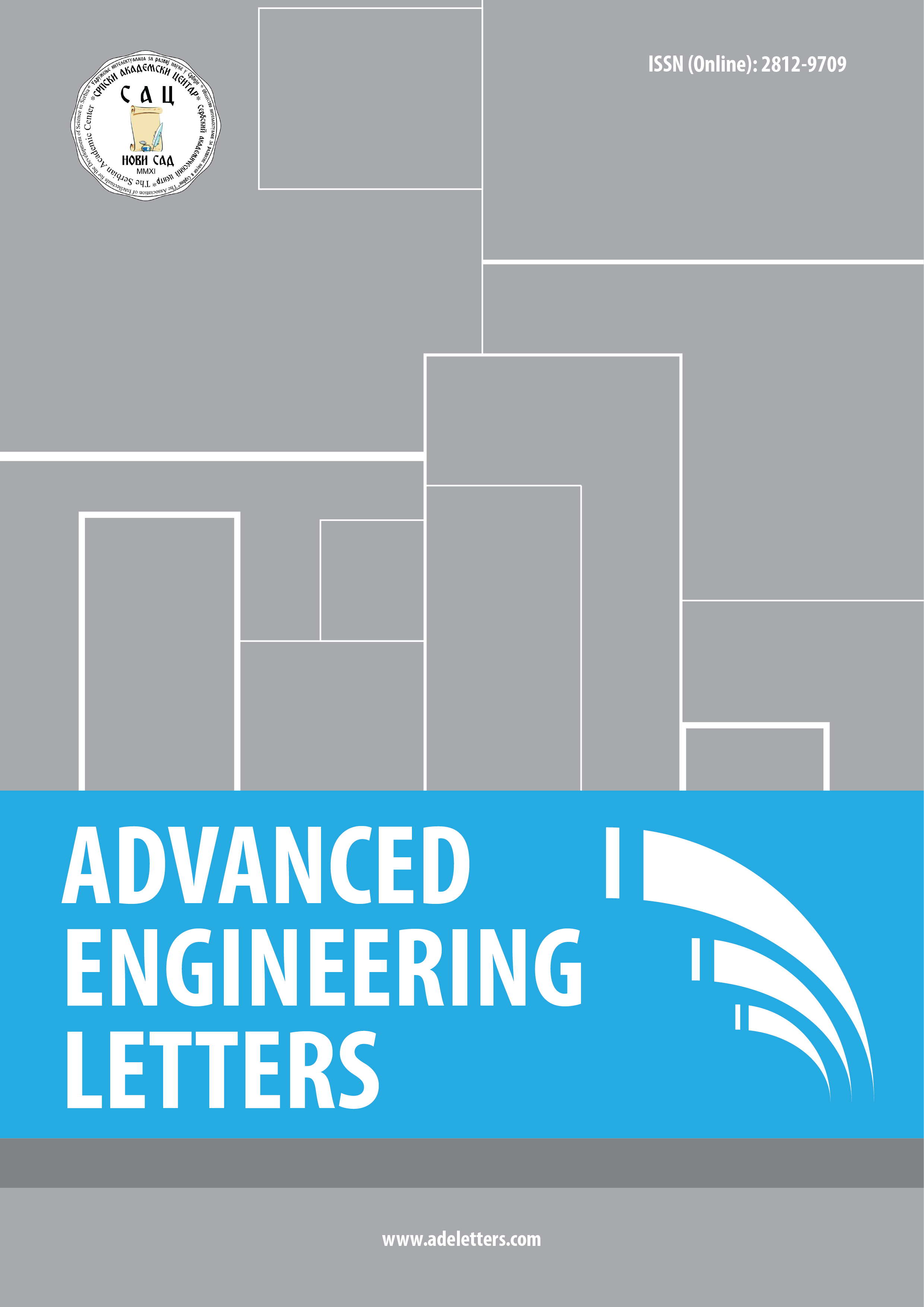ISSN (Online): 2812-9709
Vol.4, No.1, 2025: pp.1-13
Comparison of reinforcement methods with advanced materials for r/c columns
Authors:
,
,
1Bitlis Eren University, Türkiye
2University of J.J. Strossmayer, Croatia
3Islamic University of Gaza, Palestine
4University of Djillali Liabes, Algeria
Received: 16 December 2024
Revised: 9 February 2025
Accepted: 23 February 2025
Published: 31 March 2025
Abstract:
Earthquake damage in regions with high seismic risk highlights the need for. measures to improve the earthquake performance of existing structures. One such measure is strengthening these structures to bring them up to the desired performance levels. In this study, the damage to reinforced concrete (RC) buildings was examined in light of the February 6, 2023, Kahramanmaraş (Türkiye) earthquakes to identify the reinforcement needs of RC structures. Numerical analyses were conducted, considering two main factors affecting the shear force capacity in RC columns: low-strength concrete and inadequate transverse reinforcement. The columns were strengthened using four different types of fibre-reinforced polymer (FRP) wrapping, applied to all columns where the shear force was exceeded. The results for the reference building and the four different wrapping methods were compared, and suggestions were made. It was found that all four wrapping methods significantly increased the shear strength capacities of the columns without causing any failure.
Keywords:
Column, CFRP, GFRP, AFRP, BRFP, Reinforcement, Shear force capacity, Advanced materials, Sustainable structure
References:
[1] J. Yuzbasi, Controlled Demolition: Novel Monitoring and Experimental Validation of Blast-induced Full-scale Existing High-rise Building Implosion Using Numerical Finite Element Simulations. Journal of Civil Structural Health Monitoring, 2024: 1-24. https://doi.org/10.1007/s13349-024-00849-y
[2] A. Büyüksaraç, E. Isik, E. Harirchian, A Case Study for Determination of Seismic Risk Priorities in Van (Eastern Turkey). Earthquake and Structures, 20(4), 2021: 445-455. https://doi.org/10.12989/eas.2021.20.4.445
[3] E. Vuran, C. Serhatoğlu, M.Ö. Timurağaoğlu, E. Smyrou, İ.E. Bal, R. Livaoğlu, Damage Observations of RC Buildings from 2023 Kahramanmaraş Earthquake Sequence and Discussion on the Seismic Code Regulations. Bulletin of Earthquake Engineering, 2024: 1-30. https://doi.org/10.1007/s10518-023-01843-3
[4] E. Işık, M. Hadzima-Nyarko, D. Radu, B. Bulajić, Study on Effectiveness of Regional Risk Prioritisation in Reinforced Concrete Structures after Earthquakes. Applied Sciences, 14(16), 2024: 6992. https://doi.org/10.3390/app14166992
[5] B. Binici, A. Yakut, K. Kadas, K., O. Demirel, U. Akpinar, A. Canbolat, F. Yurtseven, O. Oztaskin, S. Aktas, E. Canbay, Performance of RC Buildings after Kahramanmaraş Earthquakes: Lessons Toward Performance Based Design. Earthquake Engineering and Engineering Vibration, 22(4), 2023: 883-894. https://doi.org/10.1007/s11803-023-2206-8
[6] T.P. Doğan, H. Kalkan, Ö. Aldemir, M. Ayhan, M. Böcek, Ö. Anıl, Investigation of RC Structure Damages after February 6, 2023, Kahramanmaraş Earthquake in the Hatay Region. Bulletin of Earthquake Engineering, 22(10), 2024: 5201-5229. https://doi.org/10.1007/s10518-024-01965-2
[7] M. Tan, Ö. Avşar, F. Yıldızhan, N. Atmaca, Effect of Infill Walls on the Seismic Performance of a Severely Damaged Substandard RC Building during the February 6, 2023, Kahramanmaras Earthquake Sequence. Engineering Failure Analysis, 2024: 109117. https://doi.org/10.1016/j.engfailanal.2024.109117
[8] A. Büyüksaraç, E. Işık, Ö. Bektaş, F. Avcil, Achieving Intensity Distributions of 6 February 2023 Kahramanmaraş (Türkiye) Earthquakes from Peak Ground Acceleration Records. Sustainability, 16(2), 2024: 599. https://doi.org/10.3390/su16020599
[9] M. Ozturk, M.H. Arslan, H.H. Korkmaz, Effect on RC Buildings of 6 February 2023 Turkey Earthquake Doublets and New Doctrines for Seismic Design. Engineering Failure Analysis, 153, 2023: 107521.
https://doi.org/10.1016/j.engfailanal.2023.107521
[10] E. Tapia-Hernández, M.C. Geneş, H. Guerrero- Bobadilla, Structural Behavior of Hospitals during the Kahramanmaraş Earthquake of February 6, 2023. Earthquake Spectra, 2024: 87552930241298678.
https://doi.org/10.1177/87552930241298678
[11] R. İzol, E. Işık, F. Avcil, M.H. Arslan, E. Arkan, A. Büyüksaraç, Seismic Performance of Masonry Structures after 06 February 2023 Earthquakes; Site Survey and FE Modelling Approach. Soil Dynamics and Earthquake Engineering, 186, 2024: 108904. https://doi.org/10.1016/j.soildyn.2024.108904
[12] C. Öser, S. Sarğin, A.K. Yildirim, G. Korkmaz, E. Altinok, M.K. Kelesoglu, Geotechnical Aspects and Site Investigations on Kahramanmaras Earthquakes, February 06, 2023. Natural Hazards, 2024: 1-32. https://doi.org/10.1007/s11069-024-07028-8
[13] M.F Işık, E. Işık, E. Harichian, Application of IOS/Android rapid evaluation of post- earthquake damages in masonry buildings. Gazi Mühendislik Bilimleri Dergisi, 7(1), 2021: 36-50. https://doi.org/10.30855/gmbd.2021.01.05
[14] E. Işık, M. Hadzima-Nyarko, F. Avcil, A. Büyüksaraç, E. Arkan, H. Alkan, E. Harirchian, Comparison of Seismic and Structural Parameters of Settlements in the East Anatolian Fault Zone in Light of the 6 February Kahramanmaraş Earthquakes. Infrastructures, 9(12), 2024: 219. https://doi.org/10.3390/infrastructures9120219
[15] M.R. Shendkar, D.-P.N. Kontoni, E. Işık, Determination of the Seismic Vulnerability of Infilled RC Buildings According to the Quadrants Assessment Method. Asian Journal of Civil Engineering, 25(2), 2024: 2209-2228.
https://doi.org/10.1007/s42107-023-00904-x
[16] N. Çetinkaya, H. Kaplan, Ş.M. Şenel, Betonarme Kirişlerin Lifli Polimer (Frp) Malzemeler Kullanilarak Onarim ve Güçlendirilmesi. Pamukkale Üniversitesi Mühendislik Bilimleri Dergisi, 10(3), 2011: 291-298.
[17] Z. Özcan, K. Yöntem, Betonarme Kirişlerin Kompozit Malzemeler ile Güçlendirilmesi. Deprem Sempozyumu, 2005, Kocaeli, Türkiye.
[18] M.M. Maras, Betonarme Yapıların Güçlendirilmesinde Kullanılan FRP Kompozitin Yapısal Performansa Etkisi. Avrupa Bilim ve Teknoloji Dergisi, 23, 2021: 108-119. https://doi.org/10.31590/ejosat.797437
[19] A. Sarıbıyık, Effect of Using FRP Composites as Hybrid in the Strengthening of Concretes. Sakarya University Journal of Science, 22(2), 2018: 383-391. https://doi.org/10.16984/saufenbilder.343562
[20] K.V. Çelik, H. Karaşin, H. Karbon Elyaf ile Betonun Güçlendirilmesi. Dicle Üniversitesi Mühendislik Fakültesi Mühendislik Dergisi, 5(1), 2014: 1-11.
[21] F. Colomb, H. Tobbi, E. Ferrier, P. Hamelin, Seismic Retrofit of Reinforced Concrete Short Columns by CFRP Materials. Composite Structures, 82(4), 2008: 475-487. https://doi.org/10.1016/j.compstruct.2007.01.028
[22] Z. Wang, D. Wang, S.T. Smith, D. Lu, CFRP- Confined Square RC Columns. I: Experimental Investigation. Journal of Composites for Construction, 16(2), 2012: 150-160. https://doi.org/10.1061/(ASCE)CC.1943-5614.0000245
[23] L.P. Ye, K. Zhang, S.H. Zhao, P. Feng, Experimental Study on Seismic Strengthening of RC Columns with Wrapped CFRP Sheets. Construction and Building Materials, 17(6-7), 2003: 499-506. https://doi.org/10.1016/S0950-0618(03)00047-3
[24] N.M. Saeed, B.H. Ali, M. Bigonah, A.S. Jamal, H.Z. Hassan, Impact of Structure Height on Retrofitted RC Structures for Progressive Collapse Prevention. Journal of Building Pathology and Rehabilitation, 10(1), 2025: 1-32.
https://doi.org/10.1007/s41024-024-00552-x
[25] W. Zeng, P. Ayough, X.H. Zhou, Y.H. Wang, W. Ren, M. Elchalakani, A.Y. Elghazouli, Performance of Circular CFST Columns Strengthened with CFRP Grid-reinforced ECC under Axial Compression: Numerical Modelling and Design. Engineering Structures, 325, 2025: 119375. https://doi.org/10.1016/j.engstruct.2024.119375
[26] T.P. Sathishkumar, S. Satheeshkumar, J. Naveen, Glass Fiber-reinforced Polymer Composites–a Review. Journal of Reinforced Plastics and Composites, 33(13), 2014: 1258-1275. https://doi.org/10.1177/0731684414530790
[27] Z. Li, A. Haigh, C. Soutis, A. Gibson, P. Wang, A Review of Microwave Testing of Glass Fibre- Reinforced Polymer Composites. Nondestructive Testing and Evaluation, 34(4), 2019: 429-458. https://doi.org/10.1080/10589759.2019.1605603
[28] B. Liu, L. Zhang, A. Liu, C.G. Soares, Integrated Design Method of Marine C/GFRP Hat- Stiffened Panels Towards Ultimate Strength Optimisation. Ocean Engineering, 317, 2025: 120052. https://doi.org/10.1016/j.oceaneng.2024.120052
[29] M. Dong, W. Lokuge, M. Elchalakani, A. Karrech, Modelling Glass Fibre-Reinforced Polymer Reinforced Geopolymer Concrete Columns. Structures, 20, 2019: 813-821. https://doi.org/10.1016/j.istruc.2019.06.018
[30] B. Ramesh, S. Eswari, T. Sundararajan, Flexural Behaviour of Glass Fibre Reinforced Polymer (GFRP) Laminated Hybrid-Fibre Reinforced Concrete Beams. SN Applied Sciences, 2, 2020: 1-10. https://doi.org/10.1007/s42452-020-1966-2
[31] P. Dharmavarapu, S.R. MBS, Aramid Fibre as Potential Reinforcement for polymer Matrix Composites: a Review. Emergent Materials, 5(5), 2022: 1561-1578. https://doi.org/10.1007/s42247-021-00246-x
[32] B. Zhang, L. Jia, M. Tian, N. Ning, L. Zhang, W. Wang, Surface and Interface Modification of Aramid Fiber and its Reinforcement for Polymer Composites: A Review. European Polymer Journal, 147, 2021: 110352.
https://doi.org/10.1016/j.eurpolymj.2021.110352
[33] Z.Y. Shi, P. Cui, X. Li, X. A Review on Research Progress of Machining Technologies of Carbon Fiber-Reinforced Polymer and Aramid Fiber- Reinforced Polymer. Proceedings of the Institution of Mechanical Engineers, Part C: Journal of Mechanical Engineering Science, 233(13), 2019: 4508-4520. https://doi.org/10.1177/0954406219830732
[34] R.S. Talikoti, S.B. Kandekar, Strength and Durability Study of Concrete Structures Using Aramid-Fiber-Reinforced Polymer. Fibers, 7(2), 2019: 11. https://doi.org/10.3390/fib7020011
[35] V. Fegade, M. Ramachandran, S. Madhu, C. Vimala, R.K. Malar, R. Rajeshwari, A Review on Basalt Fibre Reinforced Polymeric Composite Materials. In AIP Conference Proceedings (Vol. 2393(1), 2022: 020172.
https://doi.org/10.1063/5.0074178
[36] C. Li, D. Gao, Y. Wang, J. Tang, Effect of High Temperature on the Bond Performance Between Basalt Fibre Reinforced Polymer (BFRP) Bars and Concrete. Construction and Building Materials, 141, 2017: 44-51.
https://doi.org/10.1016/j.conbuildmat.2017.02.125
[37] M. Inman, E.R. Thorhallsson, K. Azrague, A Mechanical and Environmental Assessment and Comparison of Basalt Fibre Reinforced Polymer (BFRP) Rebar and Steel Rebar in Concrete Beams. Energy Procedia, 111, 2017: 31-40.
https://doi.org/10.1016/j.egypro.2017.03.005
[38] V. Dhand, G. Mittal, K.Y. Rhee, S.J. Park, D. Hui, A Short Review on Basalt Fiber Reinforced Polymer Composites. Composites Part B: Engineering, 73, 2015: 166-180. https://doi.org/10.1016/j.compositesb.2014.12.011
[39] Seismosoft. SeismoStruct 2024—A Computer Program for Static and Dynamic Nonlinear Analysis of Framed Structures. 2024. Available online: http://www.seismosoft.com (Accessed on 10 October 2024).
[40] Turkish Standardization Institute, Design and construction of concrete structures, Ankara, Turkey, TS500, 2000.
[41] N. Ademović, A. Muratagić, Seismic Analysis of Buildings with a Soft Storey Using Pushover Analysis. Lecture Notes in Networks and Systems, 644, 2023. https://doi.org/10.1007/978-3-031-43056-5_3
[42] A. Tena-Colunga, D.A. Hernández-García, Peak seismic demands on soft and weak stories models designed for required code nominal strength. Soil Dynamics and Earthquake Engineering, 129, 2020: 105698.
https://doi.org/10.1016/j.soildyn.2019.05.037
[43] M. Salkhordeh, F. Alishahiha, M. Mirtaheri, S. Soroushian, A rapid neural network-based demand estimation for generic buildings considering the effect of soft/weak story. Structure and Infrastructure Engineering, 20(1), 2024: 97-116. https://doi.org/10.1080/15732479.2022.2081340
[44] J.M. Jara, C. García-Calzada, B.A. Olmos, G. Martínez, Seismic response and reliability index of RC weak story buildings on soft soils of Mexico city. Journal of Building Engineering, 50, 2022: 104199. https://doi.org/10.1016/j.jobe.2022.104199
[45] J. Yuzbasi, Post-Earthquake Damage Assessment: Field Observations and Recent Developments with Recommendations from the Kahramanmaraş Earthquakes in Türkiye on February 6th, 2023 (Pazarcık M7.8 and Elbistan M7.6). Journal of Earthquake Engineering, 2024: 1-26. https://doi.org/10.1080/13632469.2024.2353864
[46] F. Akar, E. Işık, F. Avcil, A. Büyüksaraç, E. Arkan, R. İzol, Geotechnical and Structural Damages Caused by the 2023 Kahramanmaraş Earthquakes in Gölbaşı (Adıyaman). Applied Sciences, 14(5), 2024: 2165.
https://doi.org/10.3390/app14052165
[47] E. Işık, F. Avcil, R. İzol, A. Büyüksaraç, H. Bilgin, E. Harirchian, E. Arkan, Field Reconnaissance and Earthquake Vulnerability of the RC Buildings in Adıyaman during 2023 Türkiye Earthquakes. Applied Sciences, 14(7), 2024: 2860. https://doi.org/10.3390/app14072860
[48] E. Işık, F. Avcil, M. Hadzima-Nyarko, R. İzol, A. Büyüksaraç, E. Arkan, D. Radu, Z. Özcan, Seismic Performance and Failure Mechanisms of Reinforced Concrete Structures Subject to the Earthquakes in Türkiye. Sustainability, 16(15), 2024: 6473. https://doi.org/10.3390/su16156473
[49] E. Işık, M.R. Shendkar, F. Avcil, A. Büyüksaraç, S.S. Deshpande, A Study on the Determination of Damage Levels in Reinforced Concrete Structures during the Kahramanmaraş Earthquake on February 06, 2023. In E3S Web of Conferences, 405, 2023: 04029. https://doi.org/10.1051/e3sconf/202340504029
[50] H.C. Mertol, G. Tunç, T. Akış, Y. Kantekin, İ.C. Aydın, Investigation of RC Buildings after 6 February 2023, Kahramanmaraş, Türkiye Earthquakes. Buildings, 13(7), 2023: 1789. https://doi.org/10.3390/buildings13071789
[51] İ. Kazaz, Ö. Avşar, A. Dilsiz, A. Importance of Building Inspection on the Seismic Response of a Severely Damaged RC Structure during the February 6, 2023 Kahramanmaraş Earthquake Sequence. Engineering Failure Analysis, 162, 2024: 108410. https://doi.org/10.1016/j.engfailanal.2024.108410
[52] K. Jaiswal, U. Hancilar, A. Askan, M.A. Erberik, E. Cakti, A. Rao, L. Martins, A synopsis of rapid Characterization and Field-Based Performance Assessment of RC Structures from the M7. 8 Kahramanmaras Earthquake Sequence. In AGU Fall Meeting Abstracts, 2023, 2023: U44A-02.
[53] A.C. Altunişik, M.E. Arslan, V. Kahya, B. Aslan, T. Sezdirmez, G. Dok, … & A. Saribiyik, Field Observations and Damage Evaluation in Reinforced Concrete Buildings After the February 6th, 2023, Kahramanmaraş–Türkiye Earthquakes. Journal of Earthquake & Tsunami, 17(6), 2023: 2350024. https://doi.org/10.1142/S1793431123500240
[54] S. Avğın, M.M. Köse, A. Özbek, Damage Assessment of Structural and Geotechnical Damages in Kahramanmaraş during the February 6, 2023 Earthquakes. Engineering Science and Technology, an International Journal, 57, 2024: 101811. https://doi.org/10.1016/j.jestch.2024.101811
[55] B. Yön, İ.Ö. Dedeoğlu, M. Yetkin, H. Erkek, Y. Calayır, Evaluation of the Seismic Response of Reinforced Concrete Buildings in the light of Lessons Learned from the February 6, 2023, Kahramanmaraş, Türkiye Earthquake Sequences. Natural Hazards, 2024: 1-37. https://doi.org/10.1007/s11069-024-06859-9
[56] M. Yetkin, İ.Ö. Dedeoğlu, G. Tunç, February 6, 2023, Kahramanmaraş Twin Earthquakes: Evaluation of Ground Motions and Seismic Performance of Buildings for Elazığ, Southeast of Türkiye. Soil Dynamics and Earthquake Engineering, 181, 2024: 108678. https://doi.org/10.1016/j.soildyn.2024.108678
[57] İ.B. Karasin, Analytic Investigation of Hooked Stirrups on Seismic Behavior of Reinforced Concrete 3D Frame Buildings. Applied Sciences, 13(20), 2023: 11590. https://doi.org/10.3390/app132011590
[58] İ.B. Karasin, Comparative Analysis of the 2023 Pazarcık and Elbistan Earthquakes in Diyarbakır. Buildings, 13(10), 2023: 2474. https://doi.org/10.3390/buildings13102474
[59] M. Doğruyol, Characterisation of Acrylic Copolymer Treated Concretes and Concretes of Reinforced Concrete Buildings Collapsed in the 6 February 2023 Mw= 7.8 Kahramanmaraş (Türkiye) Earthquake. Engineering Failure Analysis, 161, 2024: 108249. https://doi.org/10.1016/j.engfailanal.2024.108249
[60] Y. Erbaş, Ö. Mercimek, Ö. Anıl, A. Çelik, S.T. Akkaya, İ. Kocaman, M. Gürbüz, Design Deficiencies, Failure Modes and Recommendations for Strengthening in Reinforced Concrete Structures Exposed to the February 6, 2023 Kahramanmaraş Earthquakes (Mw 7.7 and Mw 7.6). Natural Hazards, 2024: 1-42. https://doi.org/10.1007/s11069-024-06925-2
[61] O. İnce, Structural Damage Assessment of Reinforced Concrete Buildings in Adıyaman after Kahramanmaraş (Türkiye) Earthquakes on 6 February 2023. Engineering Failure Analysis, 156, 2024: 107799.
https://doi.org/10.1016/j.engfailanal.2023.107799
[62] M.L. Ivanov, W.K. Chow, Structural Damage Observed in Reinforced Concrete Buildings in Adiyaman during the 2023 Turkiye Kahramanmaras Earthquakes. Structures, 58, 2023: 105578. https://doi.org/10.1016/j.istruc.2023.105578
[63] A. Demir, H. Sezen, Seismic Performance of Industrial Buildings during the 2023 Kahramanmaras, Turkey Earthquakes. Journal of Earthquake Engineering, 2024: 1-15. https://doi.org/10.1080/13632469.2024.2390085
[64] S.K. Sezgin, G.B. Sakcalı, S. Özen, E. Yıldırım, E. Avcı, B. Bayhan, N. Çağlar, Reconnaissance Report on Damage Caused by the February 6, 2023, Kahramanmaraş Earthquakes in Reinforced-Concrete Structures. Journal of Building Engineering, 89, 2024: 109200. https://doi.org/10.1016/j.jobe.2024.109200
[65] A. Demir, E. Celebi, H. Ozturk, Z. Ozcan, A. Ozocak, E. Bol, S. Sert, F.Z. Sahin, E. Arslan, Z.D. Yaman, M. Utkucu, N. Mert, Destructive Impact of Successive High Magnitude Earthquakes Occurred in Türkiye’s Kahramanmaraş on February 6, 2023. Bulletin of Earthquake Engineering, 2024: 1-27. https://doi.org/10.1007/s10518-024-01865-5
[66] A.H. Akca, O. Sahin, K. Koc, Y. Aygörmez, Mechanical and Microstructural Investigations on Concrete of the Collapsed Buildings after Kahramanmaraş Earthquakes. Engineering Science and Technology, an International Journal, 56, 2024: 101784. https://doi.org/10.1016/j.jestch.2024.101784
[67] O. Bozdogan, A. Erdag, A. Ozdemir, Determination of Mechanical Properties of Concrete and Steel Materials Taken from Buildings in Antakya after the Kahramanmaraş Earthquakes. Case Studies in Construction Materials, 21, 2024: e03445. https://doi.org/10.1016/j.cscm.2024.e03445
[68] B. Zengin, F. Aydin, The Effect of Material Quality on Buildings Moderately and Heavily Damaged by the Kahramanmaraş Earthquakes. Applied Sciences, 13(19), 2023: 10668. https://doi.org/10.3390/app131910668
[69] C. Tura, K. Orakcal, K. Kusunoki, A. Ilki, Seismic Response Simulation of a Reinforced Concrete Wall-Frame Building That Collapsed During the February 2023 Kahramanmaras Earthquake. Journal of Earthquake Engineering, 2025: 1-25.
https://doi.org/10.1080/13632469.2024.2372080
[70] S. Antoniou, R. Pinho, R. SeismoStruct–Seismic Analysis Program by Seismosoft. Technical User Manuel. SeismoStruct, Pavia, Italy, 2003.
[71] H. Krawinkler, G.D.P.K Seneviratna, Pros and Cons of a Pushover Analysis of Seismic Performance Evaluation. Engineering Structures, 20(4-6), 1998: 452-464. https://doi.org/10.1016/S0141-0296(97)00092-8
[72] A. Salihovic, N. Ademovic, Nonlinear Analysis of Reinforced Concrete Frame Under Lateral Load. Coupled Systems Mechanics, 7(3), 2017: 281-295. https://doi.org/10.12989/csm.2018.7.3.281
[73] A.K. Chopra, R.K. Goel, R. K. (2002). A Modal Pushover Analysis Procedure for Estimating Seismic Demands for Buildings. Earthquake Engineering & Structural Dynamics, 31(3), 2002: 561-582. https://doi.org/10.1002/eqe.144
[74] A.S. Elnashai, Advanced Inelastic Static (Pushover) Analysis for Earthquake Applications. Structural Engineering and Mechanics, 12(1), 2001: 51-69. https://doi.org/10.12989/sem.2001.12.1.051
[75] N. Ademovic, M. Hrasnica, D.V. Oliveira. Pushover Analysis and Failure Pattern of a Typical Masonry Residential Building in Bosnia and Herzegovina. Engineering Structures, 50, 2013: 13-29. https://doi.org/10.1016/j.engstruct.2012.11.031
[76] TBEC. Turkish Building Earthquake Code; T.C. Resmi Gazete: Ankara, Türkiye, 2018.
© 2025 by the authors. This work is licensed under a Creative Commons Attribution-NonCommercial 4.0 International License (CC BY-NC 4.0)
![]()
How to Cite
E. Işık, M. Hadzima-Nyarko, B.A. Tayeh, Z.R. Harrat, F. Avcil, E. Arkan, Comparison of Reinforcement Methods With Advanced Materials for R/C Columns. Advanced Engineering Letters, 4(1), 2025: 1-13.
https://doi.org/10.46793/adeletters.2025.4.1.1
More Citation Formats
Işık, E., Hadzima-Nyarko, M., Tayeh, B.A., Harrat, Z.R., Avcil, F., & Arkan, E. (2025). Comparison of Reinforcement Methods With Advanced Materials for R/C Columns. Advanced Engineering Letters, 4(1), 1-13.
https://doi.org/10.46793/adeletters.2025.4.1.1
Işık, Ercan, et al. “Comparison of Reinforcement Methods With Advanced Materials for R/C Columns.“ Advanced Engineering Letters, vol. 4, no. 1, 2025, pp. 1-13.
https://doi.org/10.46793/adeletters.2025.4.1.1
Işık, Ercan, Marijana Hadzima-Nyarko, Bassam A. Tayeh, Zouaoui Rabie Harrat, Fatih Avcil, and Enes Arkan. 2025. “Comparison of Reinforcement Methods With Advanced Materials for R/C Columns.“ Advanced Engineering Letters, 4 (1): 1-13.
https://doi.org/10.46793/adeletters.2025.4.1.1
Işık, E., Hadzima-Nyarko, M., Tayeh, B.A., Harrat, Z.R., Avcil, F. and Arkan, E. (2025). Comparison of Reinforcement Methods With Advanced Materials for R/C Columns. Advanced Engineering Letters, 4(1), pp. 1-13.
doi: 10.46793/adeletters.2025.4.1.1.






